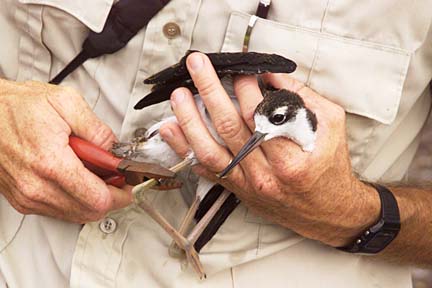


Restoring Kailua’s The really observant may have seen work crews pulling mangrove trees out of Kawainui Stream along Hamakua Drive in Kailua off and on over the past few years.
other swamp
The state is working to clear out
a habitat for native waterfowl
at Hamakua MarshBy Diana Leone
dleone@starbulletin.comBut this June, they brought in the heavy equipment, bulldozing haole koa, brush and weeds, then grinding them into mulch. Hard to miss if you drive the street that goes past the Foodland and Safeway stores in Kailua and connects the Windward town with its Enchanted Lake subdivision.
One man who saw the activity worried aloud that it might be more development, maybe shops or houses.
He can rest at ease, says David Smith, Oahu wildlife manager for the Department of Land and Natural Resources.
The 22-acre Hamakua Marsh is being restored to its former status as a wetland, in hopes of providing better habitat for native waterfowl and migrating shorebirds.
The $400,000 project will make improvements over two years. It hopes to lure more Hawaiian gallinules (alae ula), stilts (aeo), coots (alae ke okeo), ducks (koloa) and other marsh-loving birds, says Smith, who sought a grant to help fund the restoration.
Kawainui Stream used to feed the marshy area as it led out of the nearby and much larger Kawainui Marsh. But since a U.S. Army Corps of Engineers flood control dike was installed in the early 1960s, the wetland has only been wet during heavy rains.
The thick growth that covered it was held at bay only by the grazing of cattle. The shallow-water stomping ground of the birds who used to call it home was all but gone.
Restoring the marsh is a judgment call, Smith says. It is actually natural, over time, for a wetland to silt in and become dry land, he says. But since 30 percent of Hawaii wetlands have disappeared under human development, it is nice to reverse that process sometimes.
Of three DLNR wetland restoration projects on Oahu, the Hamakua Marsh is the furthest along, he says. Others are Pouhala Marsh in Waipahu, which will begin to see changes this fall, and Kawainui Marsh in Kailua, the largest fresh-water marsh in the state, for which there is an extensive master plan.
Former owner Kaneohe Ranch donated the land to the conservation group Ducks Unlimited, which in turn gave it to the state in 1995. That was when Smith started removing undesirable vegetation bit by bit -- and working on a plan for full restoration.
The Kailua Urban Design Task Force helped things along with a grant, which helps pay for the major work this summer.


Task force member Don Bremner says Honolulu City Councilman Steve Holmes deserves credit for his efforts to remove mangroves from Kawainui Stream -- both by his own hand and with volunteer helpers. Now that Smith and his crew are working on it, "Kawainui Stream is now visible (from Hamakua Drive) and exposed to people who didn't know it was there before," Bremner says.Plans to put interpretive signs along Hamakua Drive explaining the wetlands environment and its inhabitants will fit nicely with overall plans to improve Kailua town, he says.
The project also will involve the participation of students from the Kailua Hawaiian immersion school Ke Kula 'o Samuel M. Kamakau and the sixth grade at Lanikai Elementary. Kamakau curriculum coordinator Kekai Irwin said all of the school's 50 students will participate several days a month in planting native plants at Hamakua Marsh.

Lanikai teacher Wanda Harris says she looks forward to seeing what this year's sixth-graders can do to help the Hamakua Marsh project. In recent years the class has done studies on water quality in Kawainui Stream and posted the results on its award-winning Web site."Water's always been a focus for me," Harris says. She expects that this year, students will study how Hamakua Marsh has become degraded and what effects restoration efforts will have on it.
With much of the weed trees removed, Smith is concentrating on planting native trees such as aalii and kou and even friendly non-natives such as avocado and mango.
He will seek a permit to dig a well to provide a steady supply of water to the four basins in the lowlands alongside the stream. Then the kind of plants native waterbirds like, such as native sedge, can replace interlopers like pickleweed, he says.
The restoration effort includes getting rid of predators who would eat the birds the marsh will attract. Rats and mongooses will be baited with Environmental Protection Agency-approved poisons; wild cats will be trapped and taken to the Humane Society. And dogs and people will be kept out by the chain link fence.
"Last year, we had four stilt nests and three were predated by cats," Smith says. If the goal of increasing bird populations is to be achieved, predators will have to be removed.
"In two years we hope to have a patchwork of native plant species and shallow water, with native kou and milo trees," Smith says.
"It will have high educational value, being adjacent to town. The fence will keep people from getting too close to the birds, and along the Kailua urban walkway, we'll have interpretive signs."